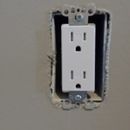Does code require fireproof caulk around electrical boxes & light switches?
We had a blower door test on our house following a major renovation (ACH50 = 4.56 on a 1920s Bungalow, Zone 2A). Several leaks identified, along with my plan to airseal them:
1) Electrical boxes & light switches (photo attached) – Caulk the gap between the electrical box & drywall, add a foam gasket behind trim plate, caulk plate to wall (on inside) & install child safety plugs in unused outlets
2) Base of interior door jams (photo attached) – Caulk
3) Exterior door weatherstripping (copper) – Bend back the copper for a more rigid fit
4) Fireplace (already sealed on interior with rigid foam, but leaked on edges) – spray foam around the edges
Questions:
– Is firecaulk required for caulking around electrical boxes (not the interior knock-outs)?
– Do child safety plugs in electrical outlets do anything to reduce air leakage? I’m putting them in for electrical safety purposes, but thinking they might also help reduce airflow
– Anything else obvious I’m missing or should consider?
Thanks,
Rob
GBA Detail Library
A collection of one thousand construction details organized by climate and house part












Replies
No, you don't need fireproof caulk. No,the plugs won't do anything. What leaks in an electrical box is the box itself, not the outlet.
I'm surprised that this is the list your auditor came up with. Your windows and doors are OK? Attic? Basement?
Agree with Dan. Go in the crawl space, attic, and basement for your primary air-sealing. It is very time consuming to try to reduce leakage by sealing electrical boxes after there's drywall.
Not sure what kind of fireplace you have, but they can be a big issue, and hard to address.
To clarify: the auditor found the leaks, however the proposed remedies are mostly mine (homeowner). I was present for the blower door test (general contractor was not), however it was the first one I've witnessed...I didn't necessarily know what to look for.
Electrical boxes: The building plan included fire-caulking all the electrical boxes. I know it was done to some degree, however I can't verify how effectively. Only evidence is some of the electrical boxes leaked during the blower door test (some much more than others)
Somewhat to my surprise, the windows all sealed well. They are all new double-pane with low-e glass & have a good seal. Windows may be something to watch...if the house settles over time (clay soil with pier & beam foundation), I may have to revisit down the road.
Door weatherstripping needed adjusting (#3 in original list, see photo) - only took me 5 minutes to bend the copper weatherstripping out. There's still a bit of a gap in the corners, but it's a much tighter fit than before.
House is a pier & beam foundation with spray foam insulation underneath - crawl space appears well sealed; nothing noted except for interior door jams (#2 on original list), which I suspect are leaking from elsewhere)
壁炉附加照片。Personally, I wanted to get rid of it...but my significant other wouldn't allow that for architectural reasons. Instead, we compromised & decided to keep it as decorative only, with our contractor attempting to seal with foam...however it appears the foam wasn't effectively sealed to the brick.
2nd floor/attic: It has a design flaw we can't change at this point (air handling in unconditioned space...don't get me started on that one), but was otherwise built with air-sealing in mind. I'm sure we missed some things, however only a small portion of the attic is accessible at this stage. Nothing identified on the blower door test.
Follow-up questions:
- Electrical boxes: Is it possible to fire caulk the electrical box itself from the inside of the box? I could see it being time-consuming, however should it be doable for a homeowner?
- Copper weatherstripping: How would you seal the corner? Seems like a weak point in the implementation of copper weatherstripping
- Fireplace: How would you further seal the fireplace? I'm thinking just another piece of rigid foam with a foam sealant.